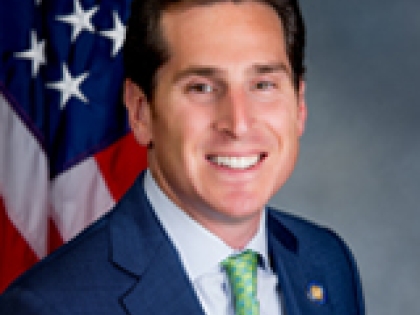
2 more Long Island school facilities shut down because of mercury vapor
Two more Long Island districts have shut down facilities after tests found mercury vapor coming from rubberlike synthetic flooring, prompting lawmakers to call for a wider state investigation into an issue that now impacts three public schools.
Tests found low levels of mercury vapor in Amityville and Merrick elementary schools, according to notices sent to parents in April and May. Miller Place closed its high school gymnasium April 28 after tests found mercury vapor above an old synthetic floor that had been covered by wood.
Schools told parents there was no threat to children and that the facilities were closed as a precaution.
Health experts said mercury vapors can accumulate in the body and eventually affect brain function, particularly in children. They also said mercury concentration levels increase during warmer weather, and when ventilation systems are shut off.
"You don’t want your kids exposed to mercury in any form, especially not in a school," said Dr. David Carpenter, director of the Institute for Health and the Environment at University at Albany. "It reduces IQ, causes reduced attention span. It's associated with more anti-social behavior … all the last things you want associated with schools."
While there's no New York state standard for mercury exposure in schools, testing reports prepared for Merrick and Amityville show concentration levels there mostly below standards set by other states for short- and long-term exposures. The levels, however, were above a U.S. Environmental Protection Agency standard for a lifetime of continuous exposure.
Miller Place has not yet released its testing reports in response to a May 7 Freedom of Information Law request.
Amityville detected mercury vapor April 11 at Park Avenue Memorial Elementary, prompted by a warning from an environmental consultant that the issue with old synthetic flooring had emerged at schools in New Jersey.
The district removed its synthetic flooring over spring break last month. Detectable levels of mercury vapor initially rose in the gymnasium, but since have dropped, according to test results. Officials believe the mercury has soaked into the concrete slab underneath and now are working on a remediation plan.
Cubs Cave — a multipurpose room that is used for physical education, lunch and other activities at Merrick's Norman J. Levy Lakeside School — closed May 7 after mercury vapor was detected.
In a letter to parents Wednesday, Merrick Superintendent Dominick Palma said the district met with environmental testing company J.C. Broderick & Associates and that the “levels of detected mercury are below available federal and state short-term exposure limits and slightly above the EPA's level for a lifetime of continuous exposure.”
Palma said negative air pressure has been introduced to the space by an environmental management company to assure that vapors do not enter other areas of the school. The school will conduct additional testing.
“The results of this expanded testing will allow the district to determine the best course of action for Cubs Cave as we move forward,” Palma said.
Miller Place High School's gymnasium has remained closed and is undergoing negative air pressure treatment and continuous air testing of the surrounding area, according to a statement Thursday from Superintendent Marianne Cartisano.
The district said it plans to remove the wood and synthetic flooring, and replace it with a new wood floor. "For the safety of our students and staff and in accordance with strict environmental guidelines, this will be done when students are not in the building," according to the statement.
Carpenter said the schools are correct to remove the flooring, or plan to do so, even with low levels of detection in the air.
It's unclear how widely rubberized floors that contain mercury have been installed on Long Island. The synthetic flooring was installed from the 1960s to the 1990s by pouring two liquid resins together. Mercury was sometimes used as a catalyst, according to a Minnesota Department of Health guideline.
A New York State Education Department official confirmed there is no regulation or guidance specific to this process, but that officials at the state level “have assisted Miller Place in expediting its remediation project and are in contact with Amityville as it decides next steps. … NYSED is working with these districts on the related construction projects on a case-by-case basis.”
On Friday, state officials said they are reaching out to Merrick as well.
State Department of Health and Department of Environmental Conservation officials said they had not been contacted by schools about the issue.
"While there are no state standards for mercury vapor exposure, investigations by the state Department of Health and other agencies have generally found mercury vapor levels in spaces with intact polyurethane flooring are low, and below levels used for health comparisons. Schools are not required to report levels to the Health Department," according to a statement from the state Department of Health.
State Sen. Todd Kaminsky (D-Long Beach) said the state should initiate an investigation into how widespread the problem is.
"We don’t want to be alarmist, but we don’t know how many gyms have mercury vapor," Kaminsky, chairman of the Senate environment committee, said after being informed of Merrick and Amityville.
Kaminsky and state Sen. Shelley Mayer (D-Yonkers) sent a letter Friday to Department of Education Commissioner MaryEllen Elia, stating: "We urge the department to initiate an investigation to determine the breadth of the issue. If the department determines there is a potential health risk, it should create a plan to ensure that gym floors in New York no longer contain mercury."
Also Friday, Kaminsky introduced a bill in the state Senate that would ban schools from installing flooring with mercury and establish a state exposure limit for mercury vapor at .75 micrograms per cubic meter.
Assemb. Steve Englebright (D-Setauket), chairman of the Assembly environment committee, when told of the two additional schools, said: "What we’re looking at is likely the tip of the iceberg, and there certainly needs to be some policy that is more than just a case-by-case basis on the part of the state."
Matthew Hamilton, spokesman for the New York State United Teachers, said the union takes potential health hazards seriously.
"While levels of possible exposure to substances like mercury vapor and other hazardous materials and chemicals vary in each situation, we encourage our members to raise any issues that they feel could impact the well-being of students, staff and visitors with their administrators," Hamilton said. "It is imperative that we work together to ensure our schools are safe for all.”
In March, the Washington Township Public School District in New Jersey approved spending $3.1 million to remove the rubberlike polyurethane flooring after mercury vapor was detected in schools there, according to news reports.
In 2017, the New Jersey Education Association and New Jersey School Board Association began investigating the link between rubberized surfaces and mercury vapor after mercury was discovered in a Burlington Township school.
The teacher's union published reports on identifying flooring that used mercury, and said "school boards and district administrators may hesitate to identify mercury-containing floors because they perceive them as a problem that could be quite costly to address and upsetting to the public."
